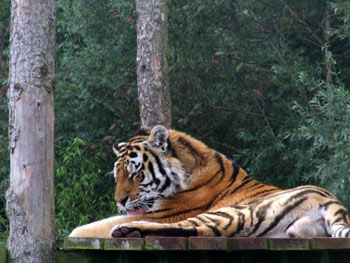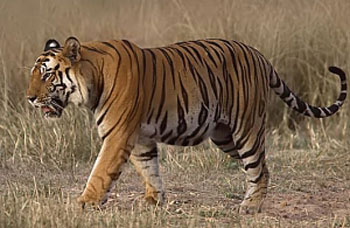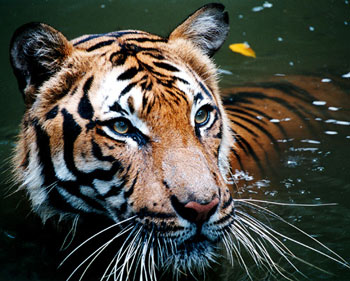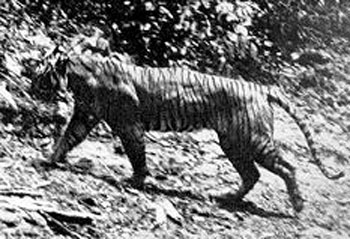MORPHOLOGY
Western and eastern gorillas are more genetically distant from one another than are chimpanzees (Pan troglodytes) and bonobos (Pan paniscus) (Butynski 2001). There are few striking physical differences between subspecies of gorilla, though differences in dentition and craniometric analyses reveal distinguishing morphological characteristics of each subspecies (Rowe 1996; Leigh et al. 2003). To some extent, even the inexperienced observer can distinguish the subspecies from one another. Mountain gorillas have significantly longer hair than their conspecifics, while western gorillas have brown, not black, hair on their heads, and eastern gorillas have longer faces and broader chests than western gorillas (Rowe 1996; Nowak 1999). Gorillas have dark brown to black fur and black skin. Dominant adult males, called silverbacks, have a prominent sagittal crest and striking silver coloration from their shoulders to rump. Males and females are sexually dimorphic, with males weighing up to 181 kg (400 lb) in the wild and 227 kg (500 lb) in captivity and measuring, on average, 1700 mm, while females weigh between 72 and 98 kg (159 and 216 lb) and measure, on average, 1500 mm (4.92 ft) (Rowe 1996).
 Gorilla gorilla gorilla
Gorilla gorilla gorilla
Photo: Rick Murphy
Spending the majority of their lives on the ground, the main locomotion pattern of gorillas is quadrupedal knuckle-walking although they do climb and spend limited amounts of time standing bipedally. Because of their sheer size, adult gorillas must climb near the main trunk of a tree or on large branches while juveniles and adolescents are more agile (Tutin et al. 1995; Rowe 1996).
Gorillas live between 30 and 40 years in the wild and up to 50 years in captivity (Stoinski pers. comm.).
RANGE
CURRENT RANGE MAPS (IUCN REDLIST):
Gorillas are patchily distributed in east central and equatorial west Africa, separated by the Congo River and its tributaries. Western gorillas (including western lowland and Cross River gorillas) are found in a geographic area of about 709,000 km² (273,746 mi²) covering parts of Nigeria, Cameroon, Central African Republic (CAR), Equatorial Guinea, Gabon, Republic of Congo, Angola, and far-western Democratic Republic of Congo (DRC). Cross River gorillas are found in only a 750 km² (290 mi²) area in Nigeria and Cameroon, a pocket of land that is isolated from the majority of this region. Eastern gorillas (including mountain and eastern lowland gorillas) are found in portions of eastern DRC, Uganda, and Rwanda, in an area approximately 112,000 km² (43,243 mi²), though mountain gorillas are restricted to two locations, Virunga Volcanoes where the borders of Uganda, Rwanda, and DRC meet, and Bwindi-Impenetrable National Park, Uganda (Nowak 1999; Butynski 2001; Sarmiento 2003).
Population estimates based on nest counts, known areas of available habitat, and population density reveal startlingly low numbers for some subspecies: as high as 110,000 (G.g. gorilla), 250 to 300 (G.g. diehli), 17,000 (G.b. graueri), and 700 (G.b. beringei) (Butynski 2001; Plumptre et al. 2003; Stoinski pers. comm.). There are about 350 gorillas in zoos in the United States, all of them are western lowland gorillas (Goodall et al. 2003).
For more than 30 years, ongoing field research on the mountain gorillas has made them the most studied subspecies of gorilla. George Schaller conducted the first long-term research study on mountain gorillas starting in 1959. In 1967, notable researcher Dian Fossey spearheaded the Karisoke Research Center in the Virunga Volcanoes and since the inception of this field site, researchers have been unraveling the complexities of gorilla society, behavior, and ecology by studying
habituated groups (it is one of the only study sites where gorillas are fully habituated). Another long-term study site is at the Lopé Reserve of Gabon, where Caroline Tutin and Michael Fernandez have been studying western lowland gorillas since 1984 (Doran & McNeilage 1997). Most of the information available about wild eastern lowland gorillas comes from studies in Kahuzi-Biega National Park in DRC (Tutin & Vedder 2001).
HABITAT
Because of their great geographical separation, about 750 km (466 mi), western and eastern gorillas live in dramatically different habitats (Tutin & Vedder 2001). Even within-species habitat variation is quite great, from swamp to montaneforest. Eastern gorillas live in submontane and montane forests from 650 to 4000 m (2132 to 13,123 ft) (Butynski 2001; Sarmiento 2003). Mountain gorillas live at the highest elevations, from 2200 to 4000 m (7218 to 13,123 ft), in the Virunga Volcanoes while eastern lowland gorillas occupy submontane forests from 700 to 2900 m (2297 to 9514 ft) (Butynski 2001). Where mountain gorillas exist, there are two rainy and two dry seasons per year, with average rainfall of 2000 mm (6.56 ft) per year (McNeilage 2001). The rainy seasons are from March until May and September to November while the dry seasons are June through August and December through February (McNeilage 2001; Robbins & McNeilage 2003). Temperatures range between 3.9° C (39° F) and 14.5° C (58° F), though they may reach 25.8° C (78.44° F) (Sarmiento 2003). Eastern lowland gorillas live in primary and secondary forests in both highland and lowland forests across their range. They occupy montane, bamboo, and lowland forests at elevations of 600 to 3308 m (1969 to 10,853 ft) (Ilambu 2001). There are two rainy seasons, the first lasting from March to June and the shorter lasting from September to December. There are also two dry seasons, the longer from June to September and the shorter from December until March (Yamagiwa et al. 1996).
 Gorilla gorilla gorilla
Gorilla gorilla gorilla
Photo: Rick Murphy
Western gorillas live in lowland, swamp, and montane forests from sea level to 1600 m (5249 ft) (Butynski 2001; Sarmiento 2003). As their common name implies, western lowland gorillas live in lowland and swamp forests at elevations up to 1600 m (5249 ft) while Cross River gorillas inhabit low-lying and submontane forests at elevations from 150 to 1600 m (492 to 5249 ft) (Sarmiento 2003). Western lowland gorillas that live in mixed swamp forests experience one rainy and one dry season per year. Average rainfall is 1526 mm (5.01 ft) with the greatest amount of rain falling between August and November and diminishing during December through March (Poulsen & Clark 2004).
ECOLOGY
The considerable dietary differences between mountain, western, and eastern lowland gorillas impact home range size and social behavior. Despite these differences, though, all gorilla groups exhibit synchronized activities and, throughout the day, alternate between rest periods and travel or feeding periods (Stewart 2001). Mountain gorillas are
folivores, feeding on leaves, stems, pith, and shoots of terrestrial herbaceous vegetation. They preferentially choose high quality, high protein, low fiber, and low tannin foods from a small number of species and incorporate little fruit into their diets (McNeilage 2001). Where bamboo is available, it is usually favored and they spend much time digging to unearth tender shoots. Because they depend on a readily available, easily accessed food source, there is little competition for resources between groups, their home ranges are small, typically between three and 15 km² (1.16 and 5.79 mi²), and they move only 500 m (.311 mi) or less within a typical day (McNeilage 2001; Robbins & McNeilage 2003). Though they only utilize a few species in each habitat, mountain gorillas show wide dietary flexibility which enables them to occupy a wide variety of habitats within their range (McNeilage 2001).
 Gorilla beringei beringei
Gorilla beringei beringei
Photo: A. W. Weber and A. Vedder
The diet of eastern lowland gorillas is more diverse than the mountain gorillas' and changes seasonally. While leaves and pith are staple parts of their diets, eastern lowland gorillas depend heavily on fruit (25 percent of their total diet), especially during the times of year when fruits are abundant. When they include insects in their diet, eastern lowland gorillas prefer ants (Yamagiwa et al. 1994). Eastern lowland gorillas generally use a small area for a few days and then travel long distances to another area. Eastern lowland gorillas that depend more heavily on fruit must travel farther in a day to find fruiting trees and have larger home ranges because of a relative scarcity of fruit. Their home ranges vary from 2.7 to 6.5 km² (1.04 to 2.51 mi²) while their day range is between 154 and 2280 m (.096 and 1.42 mi) (Yamagiwa et al. 1996).
Western lowland gorillas have little dependable access to high quality terrestrial herbs across their range, but some areas are rich in aquatic herbs and they do eat herbaceous vegetation. Fruit is widely available, though dispersed, across their range, and is a central component of their diet, especially during times of fruit abundance (Tutin 1996; Doran & McNeilage 2001; Doran et al. 2002). Termites and ants are also important dietary staples. Western lowland gorillas have the largest home ranges and travel the farthest of all gorilla subspecies because of their reliance on fruit. The average distance traveled per day is 1105 m (.687 mi) and western lowland gorillas range over seven to 14 km² (2.70 to 5.41 mi²) (Tutin 1996).
In some parts of their ranges, gorillas are sympatric with chimpanzees (Pan troglodytes) and dietary overlap in plant food and fruit is great. Where they occur together, gorillas and chimpanzees also have similar habitat use patterns and ecological competition is likely to occur (Kuroda et al. 1996). Though they share a similar niche, competition has not been recorded at any of the sites where the two apes overlap (McNeilage 2001).










 AnimalsW.com opens up a world of super high resolution Wild Cats quality stock photography, Browse by general categories and search with keywords to find what you need. Our goal is to always be able to provide you with the best Angry Tiger photos. We offer professional free Angry Tiger stock photography. Download many free high resolution Wild Cats wallpapers on this site, Please browse the site, enjoy Angry Tiger photo, and use Angry Tiger for your desktop wallpaper.
AnimalsW.com opens up a world of super high resolution Wild Cats quality stock photography, Browse by general categories and search with keywords to find what you need. Our goal is to always be able to provide you with the best Angry Tiger photos. We offer professional free Angry Tiger stock photography. Download many free high resolution Wild Cats wallpapers on this site, Please browse the site, enjoy Angry Tiger photo, and use Angry Tiger for your desktop wallpaper.
















































